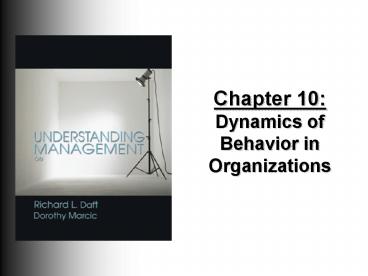Chapter 10: Dynamics of Behavior in Organizations - PowerPoint PPT Presentation
1 / 26
Title:
Chapter 10: Dynamics of Behavior in Organizations
Description:
Define attitudes, including their major components, and explain their ... themselves by disregarding ides, objects, or. people that are threatening. 7/18/09 ... – PowerPoint PPT presentation
Number of Views:1873
Avg rating:3.0/5.0
Title: Chapter 10: Dynamics of Behavior in Organizations
1
Chapter 10Dynamics of Behavior in Organizations
0
2
Learning Objectives
0
- Define attitudes, including their major
components, and explain their relationship to
personality, perception, and behavior. - Discuss the importance of work-related attitudes.
- Identify major personality traits, and describe
how personality can influence workplace attitudes
and behaviors. - Define the four components of emotional
intelligence, and explain why they are important
for todays managers. - Explain how people learn in general and in terms
of individual learning styles. - Discuss the effects of stress, and identify ways
individuals and organizations can manage stress
to improve employee health, satisfaction, and
productivity.
3
Dynamics of Behavior in Organizations
0
Managers need to understand the way individuals
groups act
Employees and managers bring their individual
differences to work each day
- Attitudes, values, personality, and behavior
influence - how people interpret an assignment,
- whether they like to be told what to do
- how they handle challenges
- how they interact with others
4
Organizational Behavior (OB)
0
- Interdisciplinary field dedicated to the study
of - attitudes
- behavior
- performance
5
Organizational Citizenship
0
- Tendency of people to help one another and put in
extra effort that goes beyond job requirements to
contribute to the organizations success.
6
Attitudes
0
- Cognitive and affective evaluation that
predisposes a person to act in a certain way - Attitudes determine how people
- Perceive the work environment
- Interact with others
- Behave on the job
Exhibit 10.1
7
High-Performance Work Attitudes
0
- Job Satisfaction - positive attitude toward ones
job - Organizational Commitment - loyalty to and heavy
involvement in ones organization
Managers of todays knowledge workers often rely
on job satisfaction to keep motivation and
enthusiasm for the organization high
8
Variations in OrganizationalCommitment
Exhibit 10.3
9
Conflicts Among Attitudes
0
- Cognitive Dissonance - condition in which two
attitudes or a behavior and an attitude conflict - Leon Festinger 1950s
- People want to behave in accordance with their
attitudes - Usually will take corrective action
10
Perception
0
- How people make sense out of the environment
- Selecting
- Organizing
- Interpreting information
Exhibit 10.4
11
Perceptual Selectivity
We tune in to some data and tune out other data
People typically focus on stimuli that satisfy
their needs
Exhibit 10.5
12
Perceptual Distortions
Stereotyping the tendency to assign an
individual to a group or broad category and then
to attribute widely held generalizations about
the group to the individual
Halo Effect an overall impression of a person
or situation based on one characteristic
favorable or unfavorable
Projection the tendency to see ones own
personal traits in other people
Perceptual Defense the tendency of perceivers
to protect themselves by disregarding ides,
objects, or people that are threatening.
13
Attributions
0
- Judgments about what caused a persons
behavioreither characteristics of the person or
of the situation - Three-factors that impact whether an attribution
will be external or internal - Distinctiveness
- Consistency
- Consensus
14
External or Internal Attributions
0
Exhibit 10.6
15
Attribution Biases
0
- Fundamental Attribution Error
- underestimate influence of external factors
- overestimate the influence of internal factors
- Self-serving Bias
- overestimate contribution of internal factors to
successes - overestimate contribution of external factors to
failures
16
Personality
0
- Set of characteristics that underlie a relatively
stable pattern of behavior in response to ideas,
objects, or people in the environment
- Big Five Personality Factors
- Extroversion
- Agreeableness
- Conscientiousness
- Emotional Stability
- Openness to Experience
17
Emotional Intelligence (EQ)Basic Components
0
- Self-Awareness
- Self-Management
- Social Awareness
- Relationship Awareness
18
Locus of Control
0
- Tendency to place primary responsibility for
ones success or failure either within oneself
(internally) or on outside forces (externally) - Internal locus of control- your actions influence
what happens to you - External locus of control- represents pawns of
fate
19
Behaviors Influenced by Personality
0
Authoritarianism belief that power and status
differences should exist within the
organization
Machiavellianism tendency to direct much of
ones behavior toward the acquisition of power
and the manipulation of other people for
personal gain
20
Problem Solving Styles
0
- Individuals differ in the way they solve problems
and make decisions - According to Jung, gathering and evaluating
information are separate activities - Gather information
- Sensation
- Intuition
- Evaluate information
- Thinking
- Feeling
21
Myers-Briggs Type Indicator (MBTI)
0
- Personality test that measures a persons
preference for - introversion vs. extroversion
- sensation vs. intuition
- thinking vs. feeling
- judging vs. perceiving
22
Person-Job Fit
- The extent to which a persons ability and
personality match the requirements of a job.
23
Learning and Learning Styles
0
Learning - change in behavior or performance that
occurs as the result of experience
- Learning Styles
- Diverger
- Assimilator
- Converger
- Accommodator
24
Experiential Learning Cycle
Exhibit 10.9
25
Stress and Stress Management
0
Type A Behavior - pattern characterized by
extreme competitiveness, impatience,
aggressiveness, and devotion to work
- Stress - physiological
- and emotional
- response to stimuli
- that place physical or psychological demands
- on an individual
Type B Behavior - pattern that lacks Type A and
includes a more balanced, relaxed lifestyle
26
Causes of Work Stress
0
- Job Tasks Demands
- Physical Demands
- Role Demand
- Interpersonal Demands































